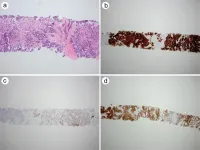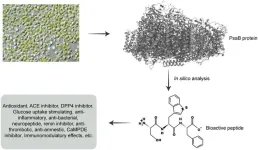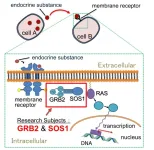(Press-News.org)
San Diego, CA (October 26, 2024) — IgA nephropathy is an autoimmune kidney disease, and complement, a component of the innate immune system, plays a role in the condition’s pathogenesis. Investigators have developed and tested a novel gene therapy that enters kidney cells and enables them to block complement activation. The research will be presented at ASN Kidney Week 2024 October 23– 27.
The gene therapy, called PS-002, uses a modified virus to treat kidney cells called podocytes. Administration of PS-002 in a mouse model of IgA nephropathy reduced signs of kidney dysfunction, lowered complement deposition, and ameliorated kidney scarring and other structural characteristics of kidney disease. In pigs, treatment with PS-002 resulted in elevated and prolonged gene expression in kidney tissues, with no safety issues.
“Our data demonstrate that targeting podocytes to modulate complement activation is an effective therapeutic strategy, and PS-002 paves the way to become the first gene therapy in development for the treatment of IgA Nephropathy,” said corresponding author Ambra Cappelletto, PhD, of Purespring Therapeutics, in London.“Purespring’s gene therapy platform exemplified by PS-002 demonstrates therapeutic genetic material can be delivered with high efficiency to podocytes, opening up a new and highly differentiated modality with the potential to treat a broad range of kidney diseases.”
Study: “Podocyte gene therapy enables glomerular complement modulation for IgA Nephropathy (IgAN) Treatment”
Join ASN and approximately 12,000 other kidney professionals from across the globe at Kidney Week 2024 in San Diego, CA. The world's premier nephrology meeting, Kidney Week, provides participants with exciting and challenging opportunities to exchange knowledge, learn the latest scientific and medical advances, and listen to engaging and provocative discussions with leading experts in the field. Early programs begin on October 23, followed by the Annual Meeting from October 24-27. Follow the conversation at #KidneyWk.
About ASN
Since 1966, ASN has been leading the fight to prevent, treat, and cure kidney diseases throughout the world by educating health professionals and scientists, advancing research and innovation, communicating new knowledge and advocating for the highest quality care for patients. ASN has nearly 21,000 members representing 140 countries. For more information, visit www.asn-online.org and follow us on Facebook, X, LinkedIn, and Instagram.
# # #
END
San Diego, CA (October 26, 2024) — Chronic active antibody-mediated rejection (caAMR) is a common cause of allograft loss after transplantation, with no approved therapies. Clazakizumab, a monoclonal antibody that targets the inflammatory cytokine interleukin-6 (IL-6), stabilized kidney transplant recipients’ kidney function in a phase 2 trial. Investigators now have data from a phase 3 trial with clazakizumab. The findings from the Phase 3 IMAGINE trial, the largest placebo-controlled study in kidney transplant recipients with caAMR, will be ...
The results of numerous high-impact phase 3 clinical trials that could affect kidney-related medical care will be presented in-person at ASN Kidney Week 2024 October 23–27.
Hyponatremia, or a chronically low blood salt level, is the most common electrolyte disorder in hospitalized patients, and is associated with higher risks of death and re-hospitalization. In a recent trial, 2,173 hospitalized patients with hyponatremia from 9 centers across Europe were assigned to undergo either targeted correction of blood salt levels according to guidelines or to receive routine care for hyponatremia. The primary outcome was the combined ...
Background and objectives
Mesothelioma is an aggressive tumor with a poor prognosis. Histological diagnosis of mesothelioma using limited tissue samples can be challenging. Carbonic anhydrase IX (CAIX) is a transmembrane protein that is overexpressed in a variety of solid tumors. This study aimed to investigate the clinical utility of CAIX expression in the differential diagnosis of pleural mesothelioma from non-small cell lung carcinoma (NSCLC).
Methods
Unstained tissue microarray slides composed of 56 cases of pleural mesothelioma and 82 cases of NSCLC were subjected to immunohistochemical staining using a mouse anti-human antibody against CAIX.
Results
Of the 38 epithelioid mesothelioma ...
Background and objectives
Chlorella vulgaris is a green, photosynthetic microalga in the phylum Chlorophyta. The goal of our study was to perform a bioinformatics analysis of Photosystem I P700 chlorophyll a apoprotein A2, one of its photosynthesis-related proteins, and to hunt for potent bioactive peptides.
Methods
To generate peptides and estimate the safety and efficacy of each bioactive peptide, we employed the tools BIOPEP-UWM™, PeptideRanker, DBAASP, and ToxinPred. PepDraw was used to understand the physicochemical properties ...
Background and objectives
Helicobacter pylori (H. pylori) infection can cause multiple secondary digestive disorders. Some studies have found that polymorphisms in Toll-like receptor (TLR) genes, including TLR10 rs10004195, may be associated with increased susceptibility to H. pylori infection. Despite conflicting reports, we conducted a meta-analysis to clarify the relationship between these factors.
Methods
We conducted an exhaustive review, encompassing all relevant literature up to February 2024, using databases ...
Background and objectives
Nail psoriasis is common in patients with plaque psoriasis and is associated with morbidity, including onychomycosis, which can complicate psoriasis treatments and be difficult to differentiate. Matrix-assisted laser desorption/ionization time-of-flight (MALDI-TOF) mass spectrometry is a fast and simple technique for identifying microorganisms through protein analysis. This study aimed to determine the sensitivity and specificity of MALDI-TOF for diagnosing onychomycosis in patients with nail psoriasis, by using conventional mycological and histological methods as the reference standard.
Methods
A prospective study was conducted on 88 patients with ...
Background and Aims
Alpha-1 antitrypsin deficiency (AATD) is a genetic disorder characterized by the misfolding and accumulation of the mutant variant of alpha-1 antitrypsin (AAT) within hepatocytes, which limits its access to the circulation and exposes the lungs to protease-mediated tissue damage. This results in progressive liver disease secondary to AAT polymerization and accumulation, and chronic obstructive pulmonary disease (COPD) due to deficient levels of AAT within the lungs. Our goal was to characterize the unique effects of COPD secondary to AATD on liver disease and gene expression.
Methods
A ...
Background and Aims
The effect of tenofovir amibufenamide (TMF) on blood lipid profiles in patients with chronic hepatitis B (CHB) remains unclear. This study aimed to explore whether TMF affects blood lipids during 48 weeks in patients with CHB.
Methods
A total of 91 patients with CHB undergoing TMF treatment for 48 weeks were divided into two groups: Lipid Normal (n = 42) and Lipid Abnormal (n = 49), based on baseline blood lipid levels. Lipid indices, virological responses, and biochemical indicators were compared between the two groups. Clinical observations were ...
Tokyo, Japan – Researchers from Tokyo Metropolitan University have uncovered new insights into how the proteins GRB2 and SOS1 in cells pass signals from membrane receptors to nuclei. They used nuclear magnetic resonance (NMR) to study how and which specific regions of GRB2 and SOS1 bind to each other, especially how they trigger liquid-liquid phase separation (LLPS). Issues with signal transduction are a major cause of cancers: understanding how it works may lead to radical new treatments.
Biological ...
San Diego, CA (October 25, 2024) — Glucagon-like peptide-1-receptor agonists (GLP-1RA) are medications that are increasingly prescribed for patients with type 2 diabetes and congestive heart failure. Reports of GLP-1RA–associated acute kidney injury (AKI) have emerged, but the risk of GLP-1RA–associated AKI among patients on anti-cancer drugs is unclear. Surprisingly, new research suggests that taking GLP-1RA is not associated with an increased risk of AKI in patients receiving anti-cancer therapies. The findings will be presented at ASN Kidney Week 2024 October 23– 27.
For the study, investigators analyzed ...


